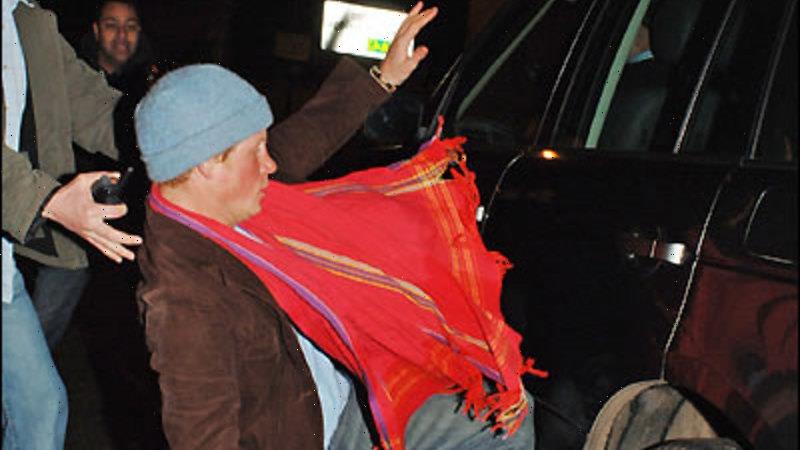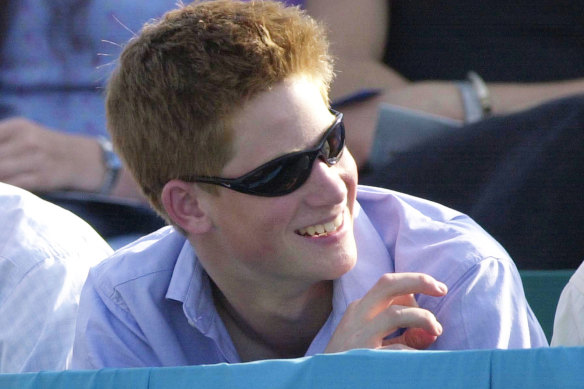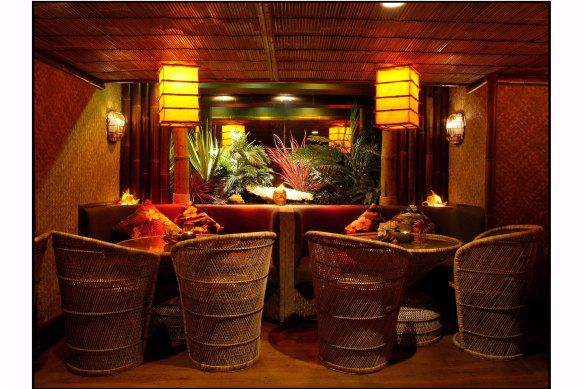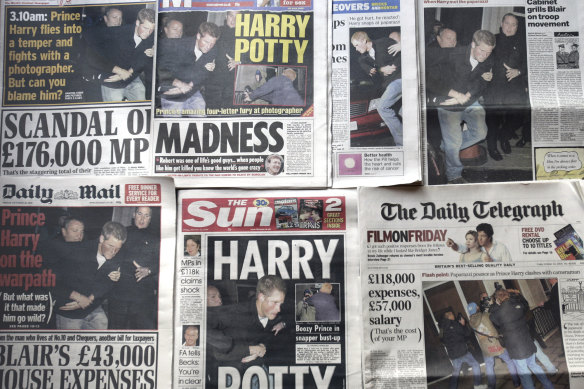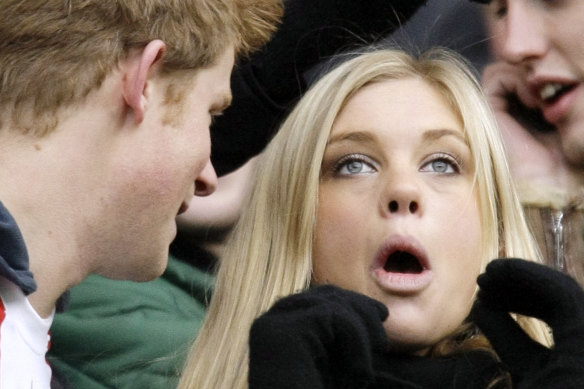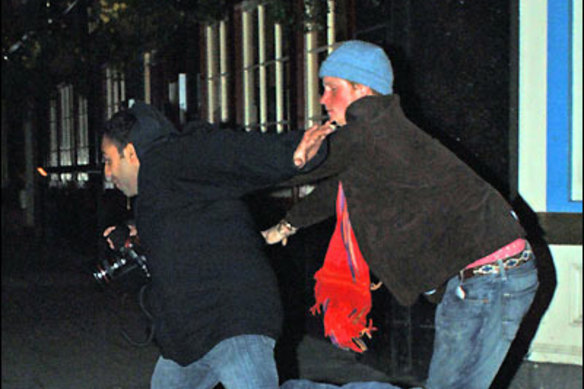Picture the scene: the music is pumping and you’re sipping a Treasure Chest – a large and lethal fruit punch filled with brandy, peach liqueur, lime and champagne and decorated with fruit “jewels” – when a man in a blue shirt and baggy trousers sidles up to you.
You protest when he takes a sip from one of your multiple coloured straws – until he removes his cap, that is, and you spot a distinctive ginger quiff.
A younger Prince Harry was known for his partying.
If you were female, pretty and in a short enough skirt, this was a scene that played out more than once in Mahiki, the glossy Mayfair nightclub that was – for a period in the Noughties – the “it” hangout of London. Much of its appeal came from the fact it was regularly frequented by one or both of the young Waleses, and Harry soon became the undisputed king of west London nightlife.
Oddly – given that partying is essentially what he was known for until Meghan came along – this is a period of time Harry barely touches upon in his autobiography Spare, which was released on Wednesday in Australia.
“Perhaps it’s convenient for his narrative that he seems to have forgotten those hedonistic days,” says Katie Nicholl, author of The New Royals and a woman who herself got into royal commentary after meeting Harry at the Kensington Roof Gardens nightclub in 2006.
Enter the Mahiki Bar, a favourite haunt of a younger Prince Harry.Credit:Rob McFarland
“On second thoughts,” Nicholl adds, “perhaps he hasn’t reminisced much because he had a lot of Vodka Redbulls and ‘Crack Baby’ shots and genuinely can’t remember it all.” Dangerously, he was also drinking for free. “William and Harry would always be taken to a table and have everything comped for the whole night.”
Mahiki was the most famous of the string of London nightclubs the princes frequented. Hedonistic, subterranean and Polynesian-themed, it typified a new, more extravagant version of nightlife that started to emerge as post-millennium London was flooded with international money.
Across the road from the Ritz, Mahiki managed to be both laidback and exclusive – a table with a bottle of vodka cost upwards of £1,000 and unless you were particularly attractive (or royal), you needed to wrangle your way on to the guest list.
Opened in 2006 and the brainchild of entrepreneur Piers Adam, it prided itself on its lack of pretension. “It brings together these different worlds: it’s Tatler meets The Sun. It’s Kensington meets Essex,” said Adam in an interview.
The sheer number of blond quiffs and suede shoes on the dancefloor suggests the clientele was more familiar with the upmarket Tatler “Bystander” column than the tabloid Sun’s “Dear Deidre” page.
“A friend and I used to play a drinking game to see how long it would take someone to ask you where you went to school – on average I would say it was about two or three minutes,” says Sarah, who worked as a nightclub promoter at the time.
Prince Harry has long had a fraught relationship with Britain’s press.Credit:AP
Harry was the leader of the tribe and once Guy Pelly – then best friend to the princes – was hired to help run Mahiki, every girl with the dream of a Kensington Palace address followed suit.
The princes felt safe there because they knew none of the managers would call the press.
“There was always a bit of a buzz on the nights Harry or William turned up – they’d come and go via the staff entrance, or even arrive wearing balaclavas,” says Lucie, who worked on the door at Mahiki in the late Noughties. “They usually stuck to a private roped-off area of the club – although I do remember Harry coming on to the main dancefloor to have some fun.”
For much of Harry’s party period, he was in the military and in an on-off relationship with Zimbabwean Chelsy Davy. Often, they went out together – but in their break-up periods, there were plenty of distractions. Promoters were charged with bringing in attractive young women: one editor, who was a fashion student at the time, said that she and her friends were regularly invited to Mahiki to enjoy a free night with drinks on tap and platters of food.
“The promoters’ job was to bring in stylish young girls,” she says. “We had no obligation other than to look good, have fun and take pictures on our digital cameras. For the most part, the partygoers respected [the royals’] privacy.”
Prince Harry, left, talks to his then- girlfriend Chelsy Davy, who was born in Zimbabwe, before the international rugby match between England and South Africa at Twickenham stadium in 2008.Credit:AP
William and Harry had to deal with increasingly hungry groups of paparazzi who would crowd the club doors in the hopes of getting a picture. One person I speak to says it was once rumoured that William was snuck out the back door while Harry was left to deal with the press. Memorably, the younger prince had a scuffle with a photographer when leaving Pangea nightclub in 2004.
Prince Harry leaves the popular celebrity haunt of Boujis in central London in the early hours of the morning. The young royal is alleged to have lashed out at paparazzi snapper Nirach Tanner before being bundled into a waiting Range Rover.
Drugs were also ubiquitous. “Of course, I had been taking cocaine at that time,” writes Harry in Spare. “At someone’s house, during a hunting weekend, I was offered a line, and since then I had consumed some more… It wasn’t very fun, and it didn’t make me feel especially happy as seemed to happen to others, but it did make me feel different, and that was my main objective. To feel. To be different.”
Now closed, Boujis was another fixture on the party circuit. Opened in 2002 in South Kensington, it was fronted by Jake Parkinson-Smith, grandson of the fashion photographer Norman Parkinson.
“Boujis was the most fun of the lot,” says Tilly, who knew the princes well at the time. “We used to have one ‘Crack Baby’ shot after another – they were vodka, champagne and passion fruit, and you could have 10 in a row and still stand upright.”
More than Mahiki, Boujis built a lot of its reputation around its royal connections. “Celebrities like Kate Moss would turn up but it was ultimately all about the princes,” says Sarah.
“People would get through the door and immediately start royal spotting – the jackpot was William and Harry, although they were happy to see Kate, Beatrice, Eugenie and Zara too.”
“It was a real feature of that period,” adds Nicholl. “The boys on their nights out and the groups of gorgeous long-limbed beauties on prince-watch.”
“Harry was a young prince and he was having fun like many of his relatives had done before him,” adds Nicholl.
“Very few people were going to berate him for that.”
Except, it seems, the new post-therapy version of Prince Harry himself.
Telegraph, London
Get a note directly from our foreign correspondents on what’s making headlines around the world. Sign up for the weekly What in the World newsletter here.
Most Viewed in World
From our partners
Source: Read Full Article
